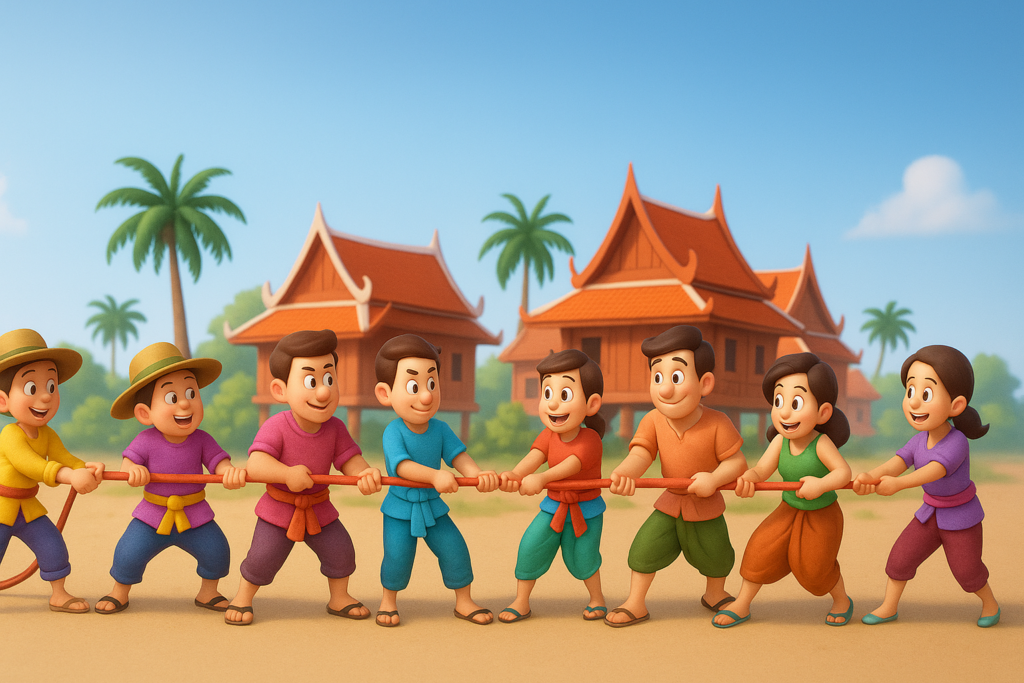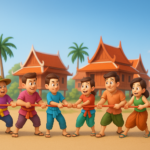Origins & History
- Ancient Beginnings:
Khmer New Year dates back more than a thousand years to the era of the Angkorian Empire. It was originally aligned with agricultural cycles, marking the end of the harvest season when farmers had free time to celebrate and honor the gods for good crops. - Hindu-Buddhist Influence:
Early Khmer culture was heavily influenced by Indian traditions. In ancient Cambodia, people celebrated the new year according to astrological beliefs, welcoming a new deity (“Moha Sangkran”) who is believed to protect the world each year. - Shift to Buddhism:
Over centuries, as Theravada Buddhism became the dominant religion, Khmer New Year absorbed Buddhist values. The festival became a time for making merit, paying respect to elders, cleansing bad karma, and praying for a prosperous year. - Historical Rituals:
Traditional celebrations involved:- Washing Buddha statues and family altars.
- Offering food to monks and ancestors.
- Lighting candles and incense.
- Playing traditional games to bring happiness.
Timing
- Date:
Khmer New Year usually falls on April 13–14–15 each year (sometimes slightly different based on the lunar calendar). - Why April?
It’s the hottest month of the year and the natural “break” between the dry and rainy seasons—ideal for resting after months of farming.
Traditional Beliefs
- Moha Sangkran:
The “New Angel” (Tevada) arrives at the start of the new year. Each year, a new angel is believed to descend to Earth to protect the people. - Merit-Making:
Families perform religious ceremonies at home and at pagodas to wash away past sins, seek blessings, and earn good merit.
Traditional Celebrations
Khmer New Year is typically celebrated in three main days:
| Day | Name | Meaning |
|---|---|---|
| Day 1 | Moha Sangkran | Welcoming the new deity. Offerings are made at home and pagodas. |
| Day 2 | Veareak Vanabat | A day of giving. Families offer charity to the poor and monks. |
| Day 3 | Veareak Laeung Sak | Cleansing rituals. People wash Buddha statues and sprinkle water to bless each other. |
Cultural Activities
- Traditional Games:
Games like Bos Angkunh, Leak Kanseng, Chol Chhoung, Bay Khom, and Tug of War are played in villages and towns. - Dancing and Music:
Folk dances like Romvong and Romkbach are performed with traditional music. - Water Splashing:
In modern times, water fights have become a big, joyful part of the celebration, especially among the youth—similar to Thailand’s Songkran. - Sand Pagoda Building:
At pagodas, families build small sand mounds symbolizing sacred mountains, decorated with colorful flags and flowers.
Khmer New Year Today
- City and Village Life:
- In cities like Phnom Penh and Siem Reap, celebrations mix tradition with modern parties, concerts, and big water fights.
- In villages, the New Year keeps a more traditional rhythm with ceremonies, games, and community gatherings.
- Family Reunions:
Many Cambodians travel back to their home provinces to spend time with family, reflecting the festival’s spirit of unity. - Modern Touch:
Today, many hotels, tourist centers, and public spaces host organized New Year events — combining traditional rituals with modern entertainment. - International Recognition:
Khmer New Year is now celebrated abroad by Cambodian communities in France, USA, Australia, Canada, and neighboring ASEAN countries.
Meaning of Khmer New Year
Khmer New Year is more than just a holiday—
✅ It is a time of gratitude,
✅ A chance to wash away the past,
✅ An opportunity to start fresh with hope, kindness, and happiness.

